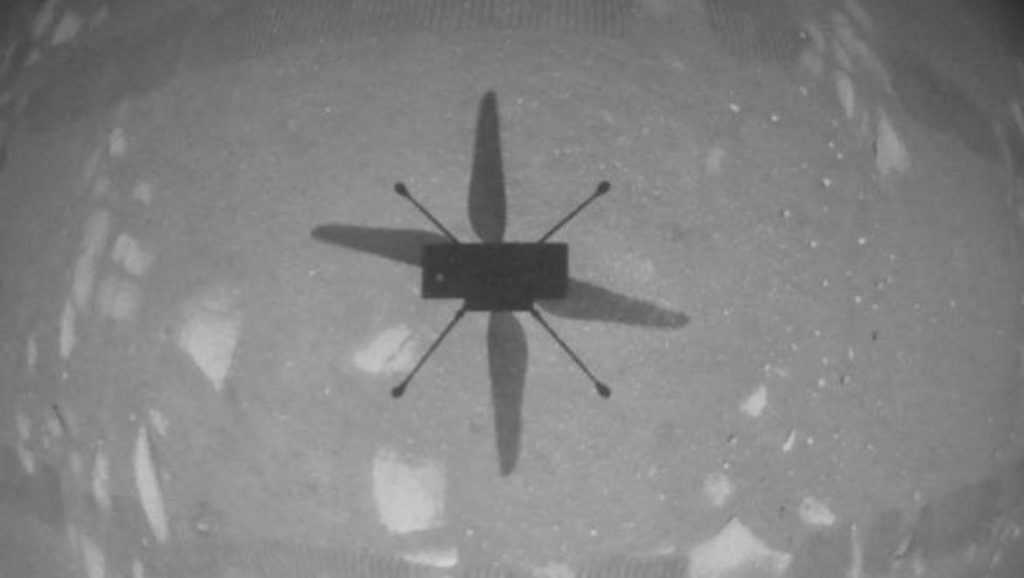
NASA successfully completed the first aircraft flight on a foreign planet on Monday, when its remotely operated helicopter, Ingenuity, took to Martian skies for nearly 40 seconds.
Ingenuity is a solar-powered rotorcraft vehicle that boasts twin propellers, a metallic body, four legs, and weighs just under two kilograms.
It was sent aboard NASA’s Perseverance Mars rover in February to complete one mission: prove that it could fly in Mars’ atmosphere, which varies significantly from that of Earth.
While Mars has much less gravitational pull than Earth, its atmosphere is just 1 per cent as dense, making it difficult to generate lift.
As such, the engineers of Ingenuity gave the aircraft four-foot long rotor blades that spin at higher speeds than would be required on Earth.
While Ingenuity’s design was tested in simulations back on Earth, Monday saw the real test of whether or not engineers had succeeded in accommodating the challenge of Mars’ atmosphere in generating lift.
The US-based space agency announced its successful first venture of Ingenuity into Mars’ aerospace during a livestream event on Monday, after NASA received its first data points showing the flight’s success touched down just after 9am local time.
For its maiden flight, Ingenuity was programmed to simply take off, soar approximately 3m above the Martian ground, hover for around 30 seconds, pivot 96 degrees, and land.
The first data received by NASA headquarters included grainy black and white images taken by Ingenuity of its own shadow below, confirming that the helicopter-like vehicle had successfully taken flight.
Whilst the flight lasted a mere 39 seconds, Ingenuity performed exactly as programmed, which saw the NASA mission managers at its Jet Propulsion Laboratory (JPL) burst into applause upon receiving those first data points.
Shortly after receiving the photos from Ingenuity itself, NASA also welcomed full-colour videos of the display sent from the Perseverance rover.
Today I witnessed history. Now you can too. You’re watching video of the #MarsHelicopter’s first flight – a true “Wright brothers” moment.
Watch it all unfold:
✅ Spin-up
✅ Takeoff
✅ Hover
✅ Turn
✅ LandingRead more: https://t.co/FIsf5RfHGj pic.twitter.com/hucsBY2RDE
— NASA's Perseverance Mars Rover (@NASAPersevere) April 19, 2021
NASA expects to receive more high-resolution images over the coming few days as all the data flows back to Earth.
NASA said the aircraft has plenty of opportunity to show off in the coming weeks, with plans for Ingenuity to take to the skies at least four more times, every three Martian days, with each flight to see the rotorcraft complete more ambitious tasks.
The next two planned flights for Ingenuity will see it fly up to five metres above Mars’ surface, and move up to 15 metres forward and backwards. Flights four and five will be dependent on the results of these earlier flights.
Ingenuity’s next flight is already planned for Thursday.
NASA’s Ingenuity project manager MiMi Aung confirmed that the first rotorcraft flight on Mars was a massive success, and called the accomplishment a “Wright Brothers moment”.
“We can now say that human beings have flown an aircraft on another planet,” Aung said.
How cool is it that the oldest living person (Kane Tanaka, a 118 year old Japanese woman) was alive for the first flight on Earth and for the first flight on Mars? #MarsHelicopter
— Tyler Roney (@TylerJRoney) April 20, 2021
Meanwhile, Ingenuity’s chief pilot at JPL Håvard Grip called the rotorcraft’s performance “flawless”.
“That’s what we told Ingenuity to do, and it did exactly that,” Grip said.
NASA referred to the occasion as a “Wright Brothers moment” a number of times, in recognition of the Wright Brothers, who are largely credited with inventing, building and flying the world’s first successful motor-operated airplane in 1903.
As such, NASA and the International Civil Aviation Organisation have officially dubbed the zone upon which Ingenuity took its maiden flight as Wright Brothers Field – Mars’ first airstrip.
Despite performing and landing in great shape, much like its first flight, Ingenuity’s career may be short lived.
NASA has confirmed it intends to push the rotorcraft to its upper physical limits, testing the extent of its speed, height and range limits.
“We will be pushing the envelope,” Aung said. “And ultimately we expect the helicopter will meet its limits.”











